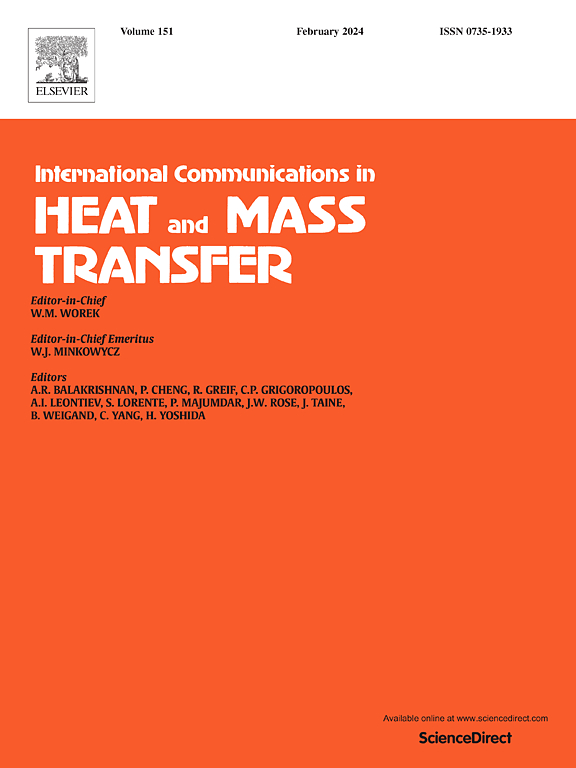Dynamics of vapor bubble train in flow boiling heat transfer in microchannels
IF 6.4
2区 工程技术
Q1 MECHANICS
International Communications in Heat and Mass Transfer
Pub Date : 2025-03-19
DOI:10.1016/j.icheatmasstransfer.2025.108859
引用次数: 0
Abstract
Microchannel flow boiling is a promising technique for micro-device thermal management, and understanding the bubble dynamics in microchannel flow boiling is important for the applications. Previous studies only focused on single, isolated bubbles, but the bubbles in microchannel flow boiling applications often exist as bubble trains, in which the bubbles interact with each other. Here, we investigate numerically vapor bubble trains in microchannel flow boiling by adopting the flow-focusing technique to form monodispersed bubbles in the upstream of the microchannel. With increasing the initial vapor–liquid volume ratio, the bubble frequency increases while the growth rate of the bubbles decreases because of the reduced bubble size. With increasing the heat flux on the wall or reducing the latent heat of the working fluid, the bubble train growth rate increases because of the increased vaporization rate. The vaporization of the fluid in the upstream causes the bubble expansion and accelerates the bubble movement in the downstream. The wall temperature and the Nusselt number fluctuate because of the periodic pass-through of bubbles.
微通道流动沸腾换热中蒸汽泡列的动力学研究
微通道流动沸腾是一种很有前途的微器件热管理技术,了解微通道流动沸腾中的气泡动力学对微通道流动沸腾的应用具有重要意义。以往的研究只关注单个、孤立的气泡,而在微通道流沸腾应用中,气泡往往以气泡列的形式存在,气泡列之间相互作用。本文采用流动聚焦技术在微通道上游形成单分散气泡,数值研究了微通道流动沸腾过程中的蒸汽泡列。随着初始气液体积比的增大,气泡频率增加,气泡体积减小,气泡生长速率降低。随着壁面热流密度的增大或工质潜热的减小,由于汽化速率的增大,泡列生长速率增大。上游流体的汽化使气泡膨胀,并加速了下游的气泡运动。由于气泡的周期性通过,壁温和努塞尔数发生波动。
本文章由计算机程序翻译,如有差异,请以英文原文为准。
求助全文
约1分钟内获得全文
求助全文
来源期刊
CiteScore
11.00
自引率
10.00%
发文量
648
审稿时长
32 days
期刊介绍:
International Communications in Heat and Mass Transfer serves as a world forum for the rapid dissemination of new ideas, new measurement techniques, preliminary findings of ongoing investigations, discussions, and criticisms in the field of heat and mass transfer. Two types of manuscript will be considered for publication: communications (short reports of new work or discussions of work which has already been published) and summaries (abstracts of reports, theses or manuscripts which are too long for publication in full). Together with its companion publication, International Journal of Heat and Mass Transfer, with which it shares the same Board of Editors, this journal is read by research workers and engineers throughout the world.

 求助内容:
求助内容: 应助结果提醒方式:
应助结果提醒方式:


